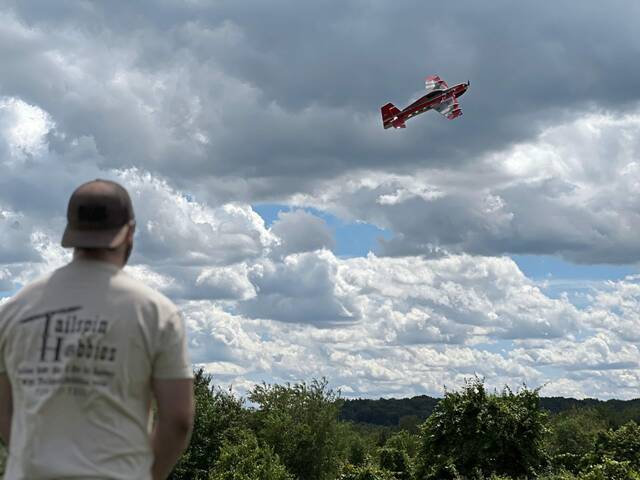https://naviga.triblive.com/local/valley-news-dispatch/rc-planes-dip-and-dazzle-at-northmoreland-park/
RC planes dip and dazzle at Northmoreland Park

The RC planes, helicopters and drones at Northmoreland Park on Sunday ranged from the simple — foam board, rubber bands and electronics — to the complex, with GPS satellite technology and First Person View goggles.
But all of them took to a picturesque blue sky dotted with grey and white clouds to put a show over the RC airfield.
Drew Clark, of Plum has been flying about two years.
“It’s like a little escape,” he said. “It’s nice while you’re flying — five to seven minutes in the air and nothing else to worry about.”
“When you’re flying, you have to think about that and nothing else,”said Joe Robinson, of Leechburg. “There are no distractions.”
The Northmoreland RC Club, which meets most Sundays at the airfield at the park, has a couple dozen members, said President Cameron Suhadolnik, who owns Tailspin Hobbies in Apollo and has been flying for about 10 years.
He hopes to continue to build the membership by demonstrating some of the planes and allowing newcomers to test them.
Do-it-yourself kits, which can be constructed out of foam poster board and a handful of mechanical parts, can cost as little as $100. A foam starter plane costs $250, including batteries and controller.
“When she’s up in the air, she looks great,” Suhadolnik said.
Even beginning models, he continued have safe mode and panic recovery for the novice.
Suhadolnik also flew an Ultra Stick on Sunday. Made out of balsa wood, he said it is a tighter flight than the planes constructed of foam.
“The balsa wood sounds much different than a foam plane,” he said. “These are much more robust and designed to last longer.”
In addition to traditional flying, the club members sometimes make a course for racing drones.
Dave Brodak, the vice president, sets up gates that the drones have to fly through as part of the race.
“There’s competition involved,” he said. “You want to go faster than somebody else.”
Some of the drones, Suhadolnik said, can reach speeds of 100 mph.
“It’s a learning curve,” he said.
The club members all recount stories of crashes and rebuilds.
“Crashing is part of learning,” Suhadolnik said.
“Super glue is your best friend,” Clark laughed.
One of Clark’s favorite planes is the P-51 Mustang, which is made to scale and has a 58-inch wingspan.
“It’s just going to look nice and fly,” he said.
Even as it dipped, spun and flipped, Clark’s plane looked smooth in the sky, despite stronger winds on Sunday.
“If you have a glider, the wind can be an advantage,” Clark said. “If you sports fly, it makes things difficult.”
But the first time Clark flew it, he said, his hands were shaking.
“You don’t want to wreck it,” he said.
The planes at the airfield are allowed to climb as high as 400 feet, Suhadolnik said.
The acrobatic maneuvers can be mesmerizing.
Robinson got his first RC airplane in 1990. On Sunday, he also flew a 15-year-old T-Rex 700E helicopter, which costs about $1,300 new.
“They’re harder to fly than airplanes,” Clark said of the helicopters. “It took a long time to learn because I was an airplane guy.”
But Robinson made it look easy as his helicopter flew upside down, flipped and rolled.
Sarah White, Clark’s girlfriend, bought her plane, a Twin Timber, last winter — and added pink striping to it.
“I made it pink because I feel like this is such a boy thing,” she said. “I had to make my mark as a girl here.”
Dave Frew, the former president of the club, retired in 2006 and started flying at the park in 2007. On Sunday, he flew a helicopter with GPS that has a run time of about 15 minutes.
Frew grew up right after World War II and during the Korean War and developed an interest in aviation and started building models.
Dan Vensel, of Saltsburg, has long had a hobby of flying RC planes.
“I’ve been doing this for 40 years, and these kids smoke me,” he said as he watched on Sunday. “These guys can do things that amaze me.”
Copyright ©2025— Trib Total Media, LLC (TribLIVE.com)
